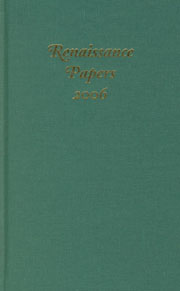Book contents
- Frontmatter
- Contents
- Renaissance Papers
- Youthes Witte: An Unstudied Elizabethan Anthology of Printed Verse and Prose Fiction
- The Power of Association: A Study in the Legitimization of Bianca Cappello through Medici Matriarchal Portraiture
- Vindicta and Vindiciae on the Early English Stage: Imagining Revenge through Huguenot Resistance Theory
- Breaking the Head of the Serpent: Women's Childbirth Prayers in The Monument of Matrones
- “Conquered nations mean nothing in love”: Political Dissent in Propertius's Elegy II.7 and Donne's “Love's Warre”
- Correcting Double Vision in The Comedy of Errors
- Lear's Awakening: Texts and Contexts
- The Power of Fantasy in Middleton's Chaste Maid: A Cost/Benefit Analysis
- Invariant Paratexts in English Dramatic Texts
- Milton and Forgiveness
- Samson at the Fair
- The End of Samson Agonistes
Lear's Awakening: Texts and Contexts
Published online by Cambridge University Press: 12 September 2012
- Frontmatter
- Contents
- Renaissance Papers
- Youthes Witte: An Unstudied Elizabethan Anthology of Printed Verse and Prose Fiction
- The Power of Association: A Study in the Legitimization of Bianca Cappello through Medici Matriarchal Portraiture
- Vindicta and Vindiciae on the Early English Stage: Imagining Revenge through Huguenot Resistance Theory
- Breaking the Head of the Serpent: Women's Childbirth Prayers in The Monument of Matrones
- “Conquered nations mean nothing in love”: Political Dissent in Propertius's Elegy II.7 and Donne's “Love's Warre”
- Correcting Double Vision in The Comedy of Errors
- Lear's Awakening: Texts and Contexts
- The Power of Fantasy in Middleton's Chaste Maid: A Cost/Benefit Analysis
- Invariant Paratexts in English Dramatic Texts
- Milton and Forgiveness
- Samson at the Fair
- The End of Samson Agonistes
Summary
THE scene of Lear's awakening and reunion with Cordelia (IV.vii in traditionally edited texts) is essential to the experience of the play and crucial to any interpretation. Not only does the scene enrich the play's tonal variety with its pathos and tender lyricism, following the great rage, hideous savagery, and wild grotesquerie of the play's central scenes, but by seeming to promise Lear some hope of release from suffering, the scene of reunion renders the final catastrophe all the more devastating.
It has long been recognized that Lear's reunion with Cordelia seems to anticipate or prefigure the romances, employing a number of dramatic, theatrical, and poetic motifs that distinguish the romances as a group from Shakespeare's other plays. Cordelia's role in restoring her father foreshadows the centrality of father-daughter relationships in all four of the romances, but especially Marina in Pericles and Perdita in The Winter's Tale, plays in which daughters function as vessels of grace, holy agents of renewal. As in the romances, the action and dialogue in the scene of Lear's awakening suggest restoration, resurrection, and rebirth in a ceremonialized atmosphere of wonder. As Marjorie Garber describes it,
This is Lear's “resurrection scene”.… The King's awakening is accompanied not only by fresh garments but also by music, which becomes … a traditional ceremonial feature of scenes of “rebirth” in the romances. (In this way the scene looks forward to the awakening of Thaisa from her coffin in Pericles; the awakening of the supposedly dead “Fidele”—the disguised Imogen—in Cymbeline; and the statue scene in The Winter's Tale.)
- Type
- Chapter
- Information
- Renaissance Papers 2006 , pp. 97 - 110Publisher: Boydell & BrewerPrint publication year: 2007



